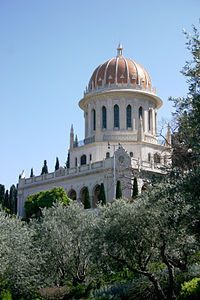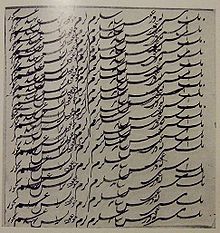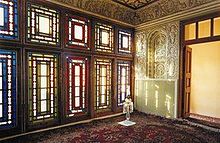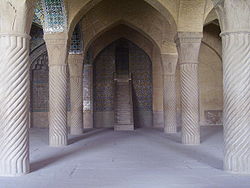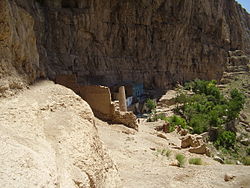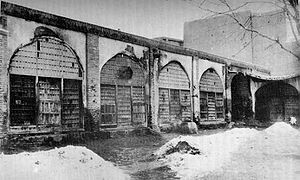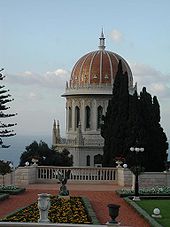- Báb
-
The title of this article contains the character á. Where it is unavailable or not desired, the name may be represented as Bab.
Central figures Bahá'u'lláh
The Báb · `Abdu'l-BaháKey scripture Kitáb-i-Aqdas · Kitáb-i-Íqán
The Hidden Words
The Seven ValleysInstitutions Administrative Order
The Guardianship
Universal House of Justice
Spiritual AssembliesHistory Notable individuals Shoghi Effendi
Martha Root · Táhirih
Badí‘ · Apostles
Hands of the CauseSee also Symbols · Laws
Index of Bahá'í Articles
Teachings · Texts
Calendar · Divisions
Pilgrimage · PrayerSiyyid `Alí Muḥammad Shírází (Persian: سيد علی محمد شیرازی) (October 20, 1819 – July 9, 1850) was the founder of Bábism, and one of three central figures of the Bahá'í Faith. He was a merchant from Shíráz, Persia, who at the age of twenty-four (on May 23, 1844) claimed to be the promised Qá'im (or Mahdi). After his declaration he took the title of Báb (Arabic: باب) meaning "Gate". He composed hundreds of letters and books (often termed tablets) in which he stated his messianic claims and defined his teachings, which constituted a new sharí'ah or religious law. His movement eventually acquired tens of thousands of supporters, was opposed by Iran's Shi'a clergy, and was suppressed by the Iranian government, leading to the persecution and killing of thousands of his followers, called Bábís. In 1850, at the age of thirty, the Báb was shot by a firing squad in Tabríz.
Bahá'ís claim that the Báb was also the spiritual return of Elijah and John the Baptist, that he was the "Ushídar-Máh" referred to in the Zoroastrian scriptures,[1] and that he was the forerunner of their own religion. Bahá'u'lláh, the founder of the Bahá'í Faith, was a follower of the Báb and claimed to be the fulfillment of his promise that God would send another messenger.
Contents
Life
Early life
Siyyid `Alí Muḥammad Shírází was born on October 20, 1819, in Shiraz to a middle-class merchant of the city. His father was Siyyid Muhammad Ridá, and his mother was Fátimih Bagum (1800-1881), a daughter of a prominent merchant in Shiraz (she later became a Bahá'í). His father died while he was quite young and the boy was raised by his maternal uncle, Hájí Mírzá Siyyid `Alí, who was also a merchant.[2][3] He claimed to be a descendant from Muhammad through Imam Husayn through both his parents.[4][5][6] When he was in Shiraz his uncle sent him to Maktab (school) and he was there for six or seven years.[7][8] Sometime between when he was 15 and 20, he joined his uncle in the family business, a trading house, and became a merchant in the city of Bushehr, Iran, near the Persian Gulf.[2][7] Some of his earlier writings suggest that he did not enjoy the family business and instead applied himself to the study of religious literature.[7] A contemporary described him as "very taciturn, and [he] would never utter a word unless it was absolutely necessary. He did not even answer our questions. He was constantly absorbed in his own thoughts, and was preoccupied with repetition of his prayers and verses. He is described as a handsome man with a thin beard, dressed in clean clothes, wearing a green shawl and a black turban."[9]
An English physician described the young man by saying: "He was a very mild and delicate-looking man, rather small in stature and very fair for a Persian, with a melodious soft voice, which struck me much"[10]
Marriage
In 1842 he married Khadíjih-Bagum (1822–1882); he was 23 and she was 20.[7] She was the daughter of a prominent merchant in Shíráz. The marriage proved to be a happy one,[11] and they had one child, a boy named Ahmad who died the year he was born (1843).[11] The pregnancy jeopardized Khadíjih-Bagum's life, and she never conceived again. The young couple occupied a modest house in Shíráz along with the Báb's mother. Later, Khadíjih-Bagum became a Bahá'í.
The Shaykhi movement
In the 1790s in Persia, Shaykh Aḥmad (1753–1826) began a religious movement within Shi'a Islam. His followers, who became known as Shaykhis, were expecting the imminent appearance of the Qá'im of the House of Muhammad, also called the Mahdi. After the death of Shaykh Ahmad, leadership was passed on to Sayyid Kázim of Rasht (1793–1843).
Around 1839–40 the Báb went on pilgrimage to Iraq, and stayed mostly in and around Karbala. There he is believed to have met the leader of the Shaykhis, Sayyid Kázim, who showed a high regard for him.[2] He is believed to have attended some of Siyyid Kazim's lectures; however, this period is almost entirely undocumented.[7]
As of his death in December 1843, Sayyid Kázim had counselled his followers to leave their homes to seek the Mahdi, who, according to his prophecies, would soon appear.[2] One of these followers, named Mullá Husayn, after keeping vigil for forty days in a mosque, travelled to Shiraz, where he met the Báb.[12]
Declaration to Mullá Husayn
Soon after he arrived in Shiraz, Mullá Husayn came into contact with the Báb. On the night of May 22, 1844, Mullá Husayn was invited by the Báb to his home; on that night Mullá Husayn told him that he was searching for the possible successor to Siyyid Kázim, the Promised One. The Báb told Mullá Husayn privately that he was Siyyid Kázim's successor and the bearer of divine knowledge.[7]
After some consideration, Mullá Husayn became the first to accept the Báb's claims as the gateway to Truth and as the initiator of a new prophetic cycle.[2][7] The Báb had replied satisfactorily to all of Mullá Husayn's questions and had written in his presence, with extreme rapidity, a long commentary of Surih of Joseph, which has come to be known as the Qayyúmu'l-Asmá' and is considered the Báb's first revealed work.[2]
Letters of the Living
Mullá Husayn was the Báb's first disciple. Within five months, seventeen other disciples of Siyyid Káẓim had independently recognized the Báb as a Manifestation of God.[13] Among them was one woman, Fátimih Zarrín Táj Baragháni, a poetess, who later received the name of Táhirih (the Pure). These 18 disciples were later to be known as the Letters of the Living and were given the task of spreading the new faith across Iran and Iraq.[7] The Báb emphasized the spiritual station of these 18 individuals, who, along with himself, made the first "Unity" of his religion[14] (in Arabic the term "unity" (Wáhid) has a numerical value of 19 using Abjad numerals). The Báb, in his book the Persian Bayán, gives the metaphorical identity of the Letters of the Living as the Fourteen Infallibles in Shí'í Islam (Muhammad, the Twelve Imams, and Fatimah) and the four archangels.[14] In some ways, they parallel the Twelve Apostles of Christ.[15]
Proclamation
In his early writings, the Báb appears to identify himself as the gate (báb) to the Hidden Twelfth Imam, and later he begins explicitly to proclaim his station as that of the Hidden Imam and a new messenger from God.[16] Rather than being a discontinued or evolving consciousness, Saiedi states that the works of the Báb are unitary throughout, and that the gradual disclosure of the Báb's identity is defined by the principle of unity in diversity throughout reality.[16]
In the Báb's early writings, the exalted identity he was claiming was unmistakable, but because of the reception of the people, his writings appear to convey the impression that he is only the gate to the Hidden Twelfth Imam.[16] To his circle of early believers, the Báb was equivocal about his exact status, gradually confiding in them that he was not merely a gate to the Hidden Imam, but the Manifestation of the Hidden Imam and the Qa'im himself.[17] During his early meetings with Mullá Husayn, the Báb described himself as the Master and the Promised One; he did not consider himself to be simply Siyyid Kazim's successor, but claimed a prophetic status, a kind of deputy, delegated not just by the Hidden Imam but through Divine authority.[18] His early texts such as the "Commentary on the Surih of Joseph" used Quranic language that implied divine authority and identified himself effectively with the Imam.[7][19] When Mullá `Alí Basṭámí, the second Letter of the Living, was put on trial in Baghdad for preaching about the Báb, clerics studied the "Commentary on the Surih of Joseph," recognized in it a claim to divine revelation, and quoted from it extensively to prove that the author had made a messianic claim.[19]
However, in the early phase of his declaration to the public, the title báb was emphasized as that of the gate leading to the Hidden Imam, as the Báb had told his early believers not to fully disclose his claims or reveal his name.[20] The approach of laying claim to a lower position was intended to create a sense of anticipation for the appearance of the Hidden Imam, as well to avoid persecution and imprisonment, because a public proclamation of mahdi status could have brought upon the Báb a swift penalty of death.[20] After a couple of months, as the Báb observed further acceptance and readiness among his believers and the public, he gradually shifted his public claim to that of the Hidden Imam.[20] Then in his final years he publicly announced his station as a Manifestation of God; in his trial, he boldly proclaimed himself, in the presence of the Heir to the Throne of Persia and other notables, to be the Promised One.[20][21] In the early months of his public declarations, the adoption of a cautious policy had essentially achieved maximum attention with minimum controversy.[20]
The gradual unfolding of his claims, however, did cause some confusion, both among the public and for some of his believers. A number of his early followers had instantly recognized his station as a messenger from God with divine authority, and this resulted in disagreement within the Bábi community.[20] Furthermore, even though the Báb had intended to convey his message with discretion, many of his followers (such as Táhirih) openly declared the coming of the promised Hidden Imam and Mahdi.[20]
Travels and imprisonment
After the eighteen Letters of the Living had recognized him, the Báb and the eighteenth Letter of the Living, Quddús, left on a pilgrimage to Mecca and Medina, the sacred cities of Islam.[7] In Mecca, the Báb wrote to the Sharif of Mecca, Custodian of the Kaaba, proclaiming his mission. After their pilgrimage, the Báb and Quddús returned to Bushehr, Iran.[3]
After some time, preaching by the Letters of the Living led to opposition by the Islamic clergy, prompting the Governor of Shiraz to order the Báb's arrest. The Báb, upon hearing of the arrest order, left Bushehr for Shiraz in June 1845 and presented himself to the authorities. He was placed under house arrest at the home of his uncle until a cholera epidemic broke out in the city in September 1846.[7] The Báb was released and departed for Isfahan. There, many came to see him at the house of the imám jum'ih, head of the local clergy, who became sympathetic. After an informal gathering where the Báb debated the local clergy and displayed his speed in producing instantaneous verses, his popularity soared.[22] After the death of the Governor of Isfahan, who had become his supporter, pressure from the clergy of the province led to the Shah, Mohammad Shah Qajar, ordering the Báb to Tehran in January 1847.[23] After spending several months in a camp outside Tehran, and before the Báb could meet the Shah, the Prime Minister sent the Báb to Tabriz in the northwestern corner of the country, where he was confined.[7]
After forty days in Tabriz, the Báb was then transferred to the fortress of Máh-Kú in the province of Azarbaijan close to the Turkish border. During his incarceration there, the Báb began his most important work, the Persian Bayán, which he never finished. Because of the Báb's growing popularity in Máh-Kú and the governor of Máh-Kú converting, the prime minister transferred him to the fortress of Chihríq in April 1848.[2] In that place as well, the Báb's popularity grew and his jailors relaxed restrictions on him. Hence the Prime Minister ordered the Báb back to Tabriz where the government called on religious authorities to put the Báb on trial for blasphemy and apostasy.[7]
Trial
The trial, attended by the Crown Prince, occurred in July 1848 and involved numerous local clergy. They questioned the Báb about the nature of his claims, his teachings, and demanded that he produce miracles to prove his divine authority. They admonished him to recant his claims. There are nine extant eyewitness reports of the trial, of which several may originate from an earlier source. Six of the reports are from Muslim accounts, and portray the Báb in an unfavourable light.[21] There are 62 questions that are found in the nine sources, however eighteen occur in only one source, fifteen in two, eight in three, five in four, thirteen in five, and three in six. Not including "yes" and "he did not answer", there are thirty-five answers, of which ten occur in one source, eight in two, six in three, three in four, two in five, five in six. Only one answer is found in all nine eyewitness sources, where the Báb states that "I am that person you have been awaiting for one thousand years."[21] His claim to Mahdihood was bold and unequivocal.
The trial did not bring a decisive result. Some clergy called for capital punishment, but the government pressured them to issue a lenient judgement because the Báb was popular. The government asked medical experts to declare the Báb insane so that he could not be executed. It is also likely that the government, to appease the religious clergy, spread rumours that the Báb had recanted.[24]
The Shaykh al-Islam (a very prominent local cleric), the champion of the anti-Bábí campaign, who was not at the Báb's trial, issued a conditional death sentence if the Báb was found to be sane. A fatwa was issued establishing the Báb's apostasy and stated "The repentance of an incorrigible apostate is not accepted, and the only thing which has caused the postponement of thy execution is a doubt as to thy sanity of mind."[24]
The crown prince's physician, William Cormick, examined the Báb and complied with the government's request to find grounds for clemency.[21] The physician's opinion saved the Báb from execution for a time, but the clergy insisted that he face corporal punishment instead, so the Báb was bastinadoed (administered twenty lashes to the bottoms of his feet).[24] The official report states that because of his harsh beating, the Báb recanted, apologized, and stated that he would not continue to advance claims of divinity.[25]
While various government sources indicate that the Báb recanted his claim, there is little non-governmental evidence of their validity. Some theorise that the assertions were made to embarrass the Báb and undermine his credibility with the public.[24] There exists an unsigned and undated document that was supposedly written shortly after the Báb's trial in Tabriz where the Báb recants his claims to a divine station. But the language of this document is very different from the Báb's usual style; it could have been prepared by the authorities, but the Báb refused to sign it.[21][24] The Báb was finally ordered back to the fortress of Chihríq.
Execution
In mid 1850 a new prime-minister, Amir Kabir,[26] ordered the execution of the Báb, probably because various Bábí insurrections had been defeated and the movement's popularity appeared to be waning. The Báb was brought back to Tabríz from Chihríq, so that he could be shot by a firing squad. The night before his execution, as he was being conducted to his cell, a young Bábí, Muḥammad-`Alíy-i-Zunúzí, called Anís, threw himself at the feet of the Báb and begged to be killed with him. He was immediately arrested and placed in the same cell as the Báb.
On the morning of July 9, 1850, the Báb was taken to the courtyard of the barracks in which he was being held, where thousands of people had gathered to watch his execution. The Báb and Anís were suspended on a wall and a large firing squad of Christian soldiers prepared to shoot.[7] Numerous eye-witness reports, including those of Western diplomats, recount the result.[27] The order was given to fire and the barracks square filled with musket smoke. When it cleared the Báb was no longer in the courtyard and his companion stood there unharmed; the bullets apparently had not harmed either man, but had cut the rope suspending them from the wall.[28] There was a great commotion, many in the crowd believing the Báb had ascended to heaven or simply disappeared. But the soldiers subsequently found the Báb in another part of the barracks, completely unharmed, giving his final instructions to his secretary. He and Anís were tied up for execution a second time, a second firing squad of Muslim soldiers was ranged in front of them, and a second order to fire was given. This time, the Báb and his companion were killed.[7] In the Bábí–Bahá'í tradition, the failure of the first firing squad to kill the Báb is believed to have been a miracle. Their remains were dumped outside the gates of the town to be eaten by animals. The remains, however, were clandestinely rescued by a handful of Bábis and were hidden. Over time the remains were secretly transported by way of Isfahan, Kirmanshah, Baghdad and Damascus, to Beirut and thence by sea to Acre on the plain below Mount Carmel in 1899.[29] On March 21, 1909, the remains were then interred in a special tomb, erected for this purpose by `Abdu'l-Bahá, on Mount Carmel in Haifa, Israel.[30] The Bahá'í World Centre is located close to this site and visitors are welcome to tour the gardens.
Succession
In most of his prominent writings, The Báb alluded to a Promised One, most commonly referred to as man yazhiruhu'lláh, "Him Whom God shall make manifest", and that he himself was "but a ring upon the hand of Him Whom God shall make manifest." Within 20 years of the Báb's death, over 25 people claimed to be the Promised One, most significantly Bahá'u'lláh.
Before the Báb's death, he sent a letter to Mírzá Yahyá, titled Subh-i-Azal, which is considered to be his will and testament.[31] The letter is recognized as appointing Subh-i-Azal to be the leader of the Bábí community after the death of the Báb. He is also ordered to obey the Promised One when he appears.[32] At the time Subh-i-Azal was still a teenager, had never demonstrated leadership in the Bábí movement, and was still living in the house of his older brother, Bahá'u'lláh. All of this lends credence to the Bahá'í claim that the Báb appointed Subh-i-Azal the head of the Bábí Faith so as to divert attention away from Bahá'u'lláh, while allowing Bábís to visit Bahá'u'lláh and consult with him freely, and allowing Bahá'u'lláh to write to Bábís easily and freely. Furthermore, there is a long history in Shí`ism of hidden leaders, with their deputies wielding the true power (the four bábs themselves are the first examples of this, as is `Alí-Muhammad's choice of the title "the Báb").
Bahá'u'lláh claimed that in 1852, while a prisoner in Tehran, he was visited by a "Maid of Heaven", which symbolically marked the beginning of his mission as a Messenger of God. Ten years later in Baghdad, he made his first public declaration and eventually was recognized by the vast majority of Bábís as "He Whom God shall make manifest". His followers began calling themselves Bahá'ís.[33]
Subh-i-Azal continued to live with or close to Bahá'u'lláh throughout the latter's exiles from Iran to Baghdad and then to Istanbul and Edirne, even though Bahá'u'lláh's claim to be a Manifestation of God in 1863 theoretically rendered moot Subh-i-Azal's authority as the head of the Bábí community. In September 1867, in Edirne, the rival claims to authority came to a head. Subh-i-Azal challenged Bahá'u'lláh to a test of the divine will in a local mosque in Edirne (Adrianople), such that "God would strike down the impostor". Bahá'u'lláh agreed and went to the Sultan Selim Mosque at the appointed time, but Mirza Yahya failed to show up.[34]
Subh-i-Azal's followers became known as Azalis or Azali Bábís. For the Bábís who did not recognize Bahá'u'lláh, Subh-i-Azal remained their leader until his death in 1912. Whether or not he had a successor is disputed. Bahá'í sources report that 11 of the 18 "witnesses" appointed by Subh-i-Azal to oversee the Bábí community became Bahá'ís, as well as his son. The man allegedly appointed by Subh-i-Azal to succeed him, Hadíy-i-Dawlat-Abádí, later publicly recanted his faith in the Báb and Subh-i-Azal.[35]
Ultimately, Bahá'u'llah emerged more successful and nearly all of the Báb's followers abandoned Subh-i-Azal and became Bahá'ís. Today Bahá'ís have several million followers, while estimates of the number of Azalís are generally around one thousand, isolated in Iran.[36]
Teachings
The Báb's teachings can be grouped into three broad stages which each have a dominant thematic focus. His earliest teachings are primarily defined by his interpretation of the Qur'an and other Islamic traditions. While this interpretive mode continues throughout all three stages of his teachings, a shift takes place where his emphasis moves to philosophical elucidation and finally to legislative pronouncements. In the second philosophical stage, the Báb gives an explanation of the metaphysics of being and creation, and in the third legislative stage his mystical and historical principles are explicitly united.[37] An analysis of the Báb's writings throughout the three stages shows that all of his teachings were animated by a common principle that had multiple dimensions and forms.[38]
Writings
Most of the writings of the Báb have been lost. The Báb himself stated they exceeded five hundred thousand verses in length; the Qur'an, in contrast, is 6300 verses in length. If one assumes 25 verses per page, that would equal 20,000 pages of text.[39] Nabíl-i-Zarandí, in The Dawn-breakers, mentions nine complete commentaries on the Qur'an, revealed during the Báb's imprisonment at Máh-Kú, which have been lost without a trace.[40] Establishing the true text of the works that are still extant, as already noted, is not always easy, and some texts will require considerable work. Others, however, are in good shape; several of the Báb's major works are available in the handwriting of his trusted secretaries.[41]
Most works were revealed in response to specific questions by Bábís. This is not unusual; the genre of the letter has been a venerable medium for composing authoritative texts as far back as the Apostle Paul. Three quarters of the chapters of the New Testament are letters, were composed to imitate letters, or contain letters within them.[42] Sometimes the Báb revealed works very rapidly by chanting them in the presence of a secretary and eye-witnesses.
The Archives Department at the Bahá'í World Centre currently holds about 190 Tablets of the Báb.[43] Excerpts from several principal works have been published in the only English-language compilation of the Báb's writings: Selections from the Writings of the Báb. Denis MacEoin, in his Sources for Early Bābī Doctrine and History, gives a description of many works; much of the following summary is derived from that source. In addition to major works, the Báb revealed numerous letters to his wife and followers, many prayers for various purposes, numerous commentaries on verses or chapters of the Qur'an, and many khutbihs or sermons (most of which were never delivered). Many of these have been lost; others have survived in compilations.[44]
The Báb has been criticized for his inconsistent use of correct and incorrect Arabic grammar in his religious works, though in his Arabic letters made very few mistakes.[45] A reason for this inconsistency could be to distinguish those who could not see past the outer form of the words from those that could understand the deeper meaning of his message.[45][46]
Writings before his declaration

Todd Lawson noted this in his doctoral dissertation about the Tafsír-i-súrih-i-baqarih or "Commentary on the Surih of the Cow", a work the Báb wrote on a chapter of the Qur'an.[47] This Qur'an commentary was started by the Báb in November or December 1843, some six months before declaring his mission. The first half was completed by February or March 1844; the second half was revealed after the Báb's declaration. It is the only work of the Báb's revealed before his declaration that has survived intact. It also sheds light on the Báb's attitude toward Shí`í beliefs.[48]
Shiraz, May – September 1844
- The first chapter of the Qayyúmu'l-Asmá' ("Commentary on the Súrih of Joseph")[49] was written by the Báb on the evening of his declaration to Mullá Husayn, May 23, 1844. The entire work, which is several hundred pages in length and is considered to be revelation by Bahá'ís, required forty days to write; it is one of the Báb's longer Arabic works. It was widely distributed in the first year of the Bábí movement, functioning as something of a Qur'an or Bible for the Bábís. In the book the Báb states his claim to be a Manifestation of God, though the claim is disguised with other statements that he is the servant of the Hidden Imám.[50] Táhirih translated the work into Persian.
- Sahífih-yi-makhzúnih, revealed before his departure for Mecca in September 1844, and consists of a collection of fourteen prayers, mostly to be recited on specific Muslim Holy Days and festivals. Its content remained within the expectations of Islam.[51]
Pilgrimage, September 1844 – June 1845
During his nine and a half month pilgrimage to Mecca, the Báb composed many works:
- Khasá'il-i-sab`ih: A work composed by the Báb on his sea journey back to Bushehr after his pilgrimage, which listed some regulations to be followed by the Bábí community. A copy of the manuscript probably still exists in Iran.[52]
- Kitáb-i-Rúḥ ("Book of the Spirit"): This book contains 700 or 900 verses and was written while the Báb was sailing back to Bushehr from pilgrimage. The original was nearly destroyed when the Báb was arrested. Several manuscript copies are extant.[53]
- Sahífih baynu'l-haramayn ("Treatise Between the Two Sanctuaries"): This Arabic work was written while the Báb traveled from Mecca to Medina in early 1845 and is in response to questions posed to him by a prominent Shaykhí leader.[54]
- Kitáb-i-Fihrist ("The Book of the Catalogue"): A list of the Báb's works, composed by the Báb himself after he returned from pilgrimage to Mecca, 21 June 1845. It is a bibliography of his earliest writings.[55]
Bushehr and Shiraz, March 1845 – September 1846
The Báb was in Bushehr March through June 1845, then in Shiraz.
- Sahífih-yi-Ja`fariyyih: The Báb wrote this treatise to an unknown correspondent in 1845. Over a hundred pages in length, it states many of his basic teachings, especially in relation to some Shaykhi beliefs.[56]
- Tafsír-i-Súrih-i-Kawthar ("Commentary on the Chapter on Abundance"): The Báb wrote this commentary for Siyyid Yahyá Dárábí Vahíd while he was in Shiraz; it is the most important work revealed during the Shiraz period. Though the súrih is only three verses in length, being the shortest in the Qur'an, the commentary on it is over two hundred pages in length. The work was widely distributed, and at least a dozen early manuscripts are extant.[57]
Isfahan, September 1846 – March 1847
- Nubuvvih khásish: This work, of fifty pages' length, was revealed in two hours in response to a question by Manúchihr Khán. It discusses the special prophethood of Muhammad, an important subject discussed in debates between Muslims and Christians.[58]
- Tafsír-i-Súrih-i-va'l-`asr (Commentary on the Chapter named "Age"): This is one of the two important works the Báb penned in Isfahan. It was written spontaneously and publicly in response to a request by Mír Sayyid Muḥammad, the chief cleric of the city; much of it was written in one evening, to the astonishment to those present.[59]
Máh-Kú, late summer 1847 – May 1848
The Báb left Isfahán in March 1847, sojourned outside Tehran several months, then was sent to a fortress at Máh-Kú, close to the Turkish border. It witnessed the composition of some of the Báb's most important works.
- Persian Bayán: This is undoubtedly the most important work of the Báb and contains the mature summary of his teachings. It was composed in Máh-Kú in late 1847 or early 1848. The work consists of nine chapters titled váhids or "unities", which in turn are usually subdivided into nineteen bábs or "gates"; the one exception is the last unity, which has only ten bábs. The Báb explained that it would be the task of "He Whom God shall make manifest" to complete the work; Bahá'ís believe Bahá'u'lláh's Kitáb-i-Iqán to be the completion of the Bayán. Each unity begins with an Arabic summary of its contents, which makes it easier to read than many of the Báb's works. Extracts of this work are published in Selections from the Writings of the Báb; A. L. M. Nicholas translated the entire work into French in four 150-page volumes.[60]
- Arabic Bayán: This is the shorter and less important of the two Bayáns. It consists of eleven váhids or "unities", each with nineteen bábs or "gates". It offers a succinct summary of the Báb's teachings and laws. It was composed at Máh-Kú in late 1847 or early 1848.[61]
- Dalá'il-i-Sab'ih ("Seven Proofs"): There are two works by this name, the longer one in Persian, the shorter one in Arabic; both were composed in Máh-Kú in late 1847 or early 1848. Nicholas called the Persian Seven Proofs "the most important of the polemical works that issued from the pen of Sayyid `Alí Muhammad".[62] The work was written to either a non-Bábí or to a follower whose faith had been shaken, but the recipient's identity is unknown.[citation needed] The Arabic text summarizes the seven proofs found in the Persian text.
Chihríq, May 1848 – July 1850
The Báb spent two years in Chihríq, except for his brief visit to Tabriz for his trial. The works he produced there were more esoteric or mystical and less thematically organized.[63] Two major books were produced, in addition to many minor works:
- Kitáb-i-Asmá' ("The Book of Names"): This is an extremely long book about the names of God. It was penned during the Báb's last days at Chihríq, before his execution. The various manuscript copies contain numerous variations in the text; the book will require considerable work to reconstruct its original text.[64]
- Kitáb-i-panj sha'n ("Book of Five Grades"): Having been composed in March and April 1850, this is one of the Báb's last works. The book consists of eighty-five sections arranged in seventeen groups, each under the heading of a different name of God. Within each group are five "grades", that is, five different sorts of sections: verses, prayers, homilies, commentaries, and Persian language pieces. Each group was sent to a different person and was composed on a different day. Thus the work is a kind of miscellany of unrelated material. Some of the sections represent further exposition of basic themes in the Báb's teachings; others consists of lengthy iterations of the names of God, and variations on their roots.[65]
See also
Notes
- ^ Shoghi, Effendi (1944). God Passes By. Wilmette, Illinois, USA: Bahá'í Publishing Trust. pp. 58. ISBN 0877430209. http://reference.bahai.org/en/t/se/GPB/gpb-5.html#pg58.
- ^ a b c d e f g Bausani, A. (1999). "Bāb". Encyclopedia of Islam. Leiden, The Netherlands: Koninklijke Brill NV.
- ^ a b Balyuzi, H.M. (1973). The Báb: The Herald of the Day of Days. Oxford, UK: George Ronald. pp. 30–41. ISBN 0853980489.
- ^ Balyuzi, H.M. (1973). The Báb: The Herald of the Day of Days. Oxford, UK: George Ronald. pp. 32. ISBN 0853980489.
- ^ "Overview of the Bábi Faith". Bahá'í International Community. http://info.bahai.org/babi-faith.html. Retrieved 2008-04-09.
- ^ "The Genealogy of Bab, showing connection with Bahá'u'lláh's descendants, by Mirza Abid, Published in Nabil's Dawnbreakers". bahai.library.org. http://bahai-library.com/abid_dawnbreakers_genealogy_babi. Retrieved 2008-04-09.
- ^ a b c d e f g h i j k l m n o MacEoin, Dennis (1989). "Bāb, Sayyed `Ali Mohammad Sirazi". Encyclopædia Iranica.
- ^ Lambden, Stephen (1986). "An Episode in the Childhood of the Báb". In Smith, Peter. Studies in Bábí and Bahá'í History - volume three - In Iran. Kalimát Press. pp. 1–31. ISBN 0-933770-16-2. http://bahai-library.com/articles/episode.bab.html.
- ^ Hajji Muhammad Husayn, quoted in Amanat, Abbas (1989). Resurrection and Renewal: The making of the Babi Movement in Iran, 1844-1850. Ithaca: Cornell University Press. pp. 132–33.
- ^ H.M. Balyuzi, The Bab - The Herald of the Day of Days, p. 146
- ^ a b H.M. Balyuzi, Khadijih Bagum - Wife of the Bab
- ^ Balyuzi, pp. 13.
- ^ "The Time of the Báb". BBC. http://www.bbc.co.uk/religion/religions/bahai/history/bab_2.shtml. Retrieved 2006-07-02.
- ^ a b Amanat, Resurrection and Renewal, 191.
- ^ Momen, Moojan (1995). "Bahá’u’lláh’s prophetology: archetypal patterns in the lives of the founders of the world religions". Bahá'í Studies Review 5 (1).
- ^ a b c Saiedi, Nader (2008). Gate of the Heart. Waterloo, ON: Wilfrid Laurier University Press. pp. 19. ISBN 978-1-55458-035-4. http://books.google.com/?id=XTfoaK15t64C&printsec=frontcover&dq=Understanding+the+Writings+of+the+B%C3%A1b&cd=1#v=onepage&q=.
- ^ Amanat, Abbas (2000). "Resurgence of Apocalyptic in Modern Islam". In Stein, Stephen J.. The Encyclopedia of Apocalypticism, vol. III: Apocalypticism in the Modern Period and the Contemporary Age.. New York: Continuum. pp. 241–242. ISBN 0826412556.
- ^ Amanat, Resurrection and Renewal, 171.
- ^ a b Amanat, Resurrection and Renewal, 230-31.
- ^ a b c d e f g Manuchehri, Sepehr (1999). "The Practice of Taqiyyah (Dissimulation) in the Babi and Bahai Religions". Research Notes in Shaykhi, Babi and Baha'i Studies 3 (3). http://www.h-net.org/~bahai/notes/vol3/taqiya.htm. Retrieved 2007-09-23.
- ^ a b c d e MacEoin, Denis (May 1997). "The Trial of the Bab: Shi'ite Orthodoxy Confronts its Mirror Image". Occasional Papers in Shaykhi, Babi and Baha'i Studies 1. http://www.h-net.org/~bahai/bhpapers/babtrial.htm. Retrieved 2006-07-02.
- ^ Amanat, Resurrection and Renewal, 257.
- ^ Amanat, Resurrection and Renewal, 258.
- ^ a b c d e Amanat, Abbas (1989). Resurrection and Renewal: The Making of the Babi Movement in Iran. Ithaca: Cornell University Press. pp. 390–393.
- ^ Browne, E.G. (1918). Materials for the Study of the Babi Religion. Cambridge: Cambridge University Press.
- ^ Shoghi, Effendi (1944). God Passes By. Wilmette, Illinois, USA: Bahá'í Publishing Trust. pp. 52. ISBN 0877430209. http://reference.bahai.org/en/t/se/GPB/gpb-5.html#pg52.
- ^ Sir Justin Shiel, Queen Victoria's Envoy Extraordinary and Minister Plenipotentiary in Tehran, wrote to Lord Palmerston, the British Secretary of State for Foreign Affairs, on July 22, 1850, regarding the execution. The letter, can be found in its original form as document F.O. 60/152/88 in the archives of the Foreign Office at the Public Records Office in London.
- ^ Some accounts say Anís was killed on the first volley; one says that the Báb was dispatched by a sword. See Firuz Kazemzadeh, Kazem Kazemzadeh, and Howard Garey, "The Báb: Accounts of His Martyrdom", in World Order, vol. 8, no. 1 (Fall, 1973), 32. All accounts, even the Muslim ones, concur that the Báb survived the first volley.
- ^ Shoghi, Effendi (1944). God Passes By. Wilmette, Illinois, USA: Bahá'í Publishing Trust. pp. 273–289. ISBN 0877430209. http://reference.bahai.org/en/t/se/GPB/gpb-19.html.
- ^ Brian D. Lepard (October 2008). In The Glory of the Father: The Baha'i Faith and Christianity. Baha'i Publishing Trust. p. 50. ISBN 9781931847346. http://books.google.com/books?id=v2ob2Tw2k3MC&pg=PA50. Retrieved 20 March 2011.
- ^ Last will and testament
- ^ Manuchehri (2004)
- ^ Cole, Juan. "A Brief Biography of Baha'u'llah". http://www-personal.umich.edu/~jrcole/bahabio.htm. Retrieved 2006-06-22.
- ^ Browne (1918) p. 18. & Salmání (1982) pp. 94-95
- ^ Shoghi Effendi (1944) p. 233 & Momen (1991) pp. 99
- ^ "Azali". Britannica Concise. http://concise.britannica.com/ebc/article-9356264. Retrieved 2006-10-14.
- ^ Saiedi, Nader (2008). Gate of the Heart. Waterloo, ON: Wilfrid Laurier University Press. pp. 27–28. ISBN 978-1-55458-035-4. http://books.google.com/?id=XTfoaK15t64C&printsec=frontcover&dq=Understanding+the+Writings+of+the+B%C3%A1b&cd=1#v=onepage&q=.
- ^ Saiedi, Nader (2008). Gate of the Heart. Waterloo, ON: Wilfrid Laurier University Press. pp. 49. ISBN 978-1-55458-035-4. http://books.google.com/?id=XTfoaK15t64C&printsec=frontcover&dq=Understanding+the+Writings+of+the+B%C3%A1b&cd=1#v=onepage&q=.
- ^ MacEoin, Sources for Early Bābī Doctrine and History, 15.
- ^ Denis MacEoin, The Sources for Early Bābī Doctrine and History (Leiden: Brill, 1992), 88.
- ^ MacEoin, Sources for Early Bābī Doctrine and History, 12-15.
- ^ On letters as a medium of composition of the New Testament, see Norman Perrin, The New Testament: An Introduction, Proclamation and Parenesis, Myth and History (New York: Harcourt Brace Jovanovitch, 1974), 96-97.
- ^ Unpublished letter from the Universal House of Justice. "Numbers and Classifications of Sacred Writings Texts". http://bahai-library.com/uhj_numbers_sacred_writings. Retrieved 2006-12-16.
- ^ MacEoin, Sources for Early Bābī Doctrine and History, 15-40.
- ^ a b William McCants. "Arabic Grammar of the Bab, The". http://bahai-library.com/mccants_arabic_grammar_bab. Retrieved 2008-03-26.
- ^ Todd Lawson. "Qur'an Commentary of Sayyid 'Alí Muhammad, the Báb, The (Doctoral dissertation)". http://bahai-library.com/lawson_quran_commentary_bab. Retrieved 2008-03-26.
- ^ B. Todd Lawson, The Qur'an Commentary of Sayyid `Alî Muḥammad, the Bab, Ph.D. diss, Institute of Islamic Studies, McGill Univ., Montreal, 1987, 250-51.
- ^ MacEoin, Sources for Early Bābī Doctrine and History, 46-47.
- ^ Hands of the Cause Residing in the Holy Land, Ed. "Bahá'í Faith, The: 1844-1963". pp. 13. http://bahai-library.com/handscause_statistics_1953-63&chapter=1#13. Retrieved 2006-07-02.
- ^ MacEoin, Sources for Early Bābī Doctrine and History, 55-57.
- ^ MacEoin, Sources for Early Bābī Doctrine and History, 59-60.
- ^ MacEoin, Sources for Early Bābī Doctrine and History, 61-63.
- ^ MacEoin, Sources for Early Bābī Doctrine and History, 61.
- ^ MacEoin, Sources for Early Bābī Doctrine and History, 60-61.
- ^ MacEoin, Sources for Early Bābī Doctrine and History, 65.
- ^ MacEoin, Sources for Early Bābī Doctrine and History, 66-67.
- ^ MacEoin, Sources for Early Bābī Doctrine and History, 71; Nabíl-i-Zarandí, The Dawn-breakers, 174-76.
- ^ MacEoin, Sources for Early Bābī Doctrine and History, 76-77; Amanat, Resurrection and Renewal, 257; Nabíl-i-Zarandí, The Dawn-breakers, 202-04.
- ^ MacEoin, Sources for Early Bābī Doctrine and History, 76.
- ^ MacEoin, Sources for Early Bābī Doctrine and History, 83-85.
- ^ MacEoin, Sources for Early Bābī Doctrine and History, 85.
- ^ MacEoin, Sources for Early Bābī Doctrine and History, 85-88.
- ^ MacEoin, Sources for Early Bābī Doctrine and History, 88-94.
- ^ MacEoin, Sources for Early Bābī Doctrine and History, 91-92.
- ^ MacEoin, Sources for Early Bābī Doctrine and History, 93-95.
References
Bahá'í resources
- `Abdu'l-Bahá; Browne, E.G. (Tr.) (1891). A Traveller's Narrative: Written to illustrate the episode of the Bab. Cambridge University Press. http://www.h-net.org/~bahai/diglib/books/A-E/B/browne/tn/hometn.htm. Retrieved 2007-02-21.
- `Abdu'l-Bahá; Browne, E.G. (Tr.) (1891). A Traveller's Narrative: Written to illustrate the episode of the Bab (2004 reprint, with translator's notes ed.). Los Angeles, USA: Kalimát Press. ISBN 1890688371. http://reference.bahai.org/en/t/ab/TN/. Retrieved 2007-02-21.
- Afnán, Mírzá Habíbu’lláh (n.d.) (PDF). The Báb in Shiraz: An Account by Mírzá Habíbu’lláh Afnán. http://ahang.rabbani.googlepages.com/TheBabinShiraz.pdf. Retrieved 2008-05-23.
- Balyuzi, H.M. (1973). The Báb: The Herald of the Day of Days. Oxford, UK: George Ronald. ISBN 0853980489.
- Effendi, Shoghi (1944). God Passes By. Wilmette, Illinois, USA: Bahá'í Publishing Trust. ISBN 0877430209. http://reference.bahai.org/en/t/se/GPB/. Retrieved 2007-02-21.
- Ferraby, John (1975). All Things Made New: A Comprehensive Outline of the Bahá'í Faith. Bahá'í Distribution Service. ISBN 8186953019.
- Saiedi, Nader (2008). Gate of the Heart: Understanding the Writings of the Báb. Canada: Wilfrid Laurier University Press. ISBN 9781554580569. http://books.google.com/?id=XTfoaK15t64C.
- Taherzadeh, A. (1976). The Revelation of Bahá'u'lláh, Volume 1: Baghdad 1853-63. Oxford, UK: George Ronald. ISBN 0853982708. http://www.peyman.info/cl/Baha'i/Others/ROB/V1/Cover.html.
- Taherzadeh, A. (1977). The Revelation of Bahá'u'lláh, Volume 2: Adrianople 1863-68. Oxford, UK: George Ronald. ISBN 0853980713. http://www.peyman.info/cl/Baha'i/Others/ROB/V2/Cover.html.
- Taherzadeh, A. (1984). The Revelation of Bahá'u'lláh, Volume 3: `Akka, The Early Years 1868-77. Oxford, UK: George Ronald. ISBN 0853981442. http://www.peyman.info/cl/Baha'i/Others/ROB/V3/Cover.html.
- Taherzadeh, A. (1987). The Revelation of Bahá'u'lláh, Volume 4: Mazra'ih & Bahji 1877-92. Oxford, UK: George Ronald. ISBN 0853982708. http://www.peyman.info/cl/Baha'i/Others/ROB/V4/Cover.html.
- Nabíl-i-Zarandí (1932). Shoghi Effendi (Translator). ed. The Dawn-Breakers: Nabíl’s Narrative (Hardcover ed.). Wilmette, Illinois, USA: Bahá'í Publishing Trust. ISBN 0900125225. http://reference.bahai.org/en/t/nz/DB/. Retrieved 2007-02-21.
Other resources
- Amanat, Abbas (1989). Resurrection and Renewal. Ithaca, New York, USA: Cornell University Press. ISBN 0-8014-2098-9.
- Anonymous; Browne, E.G. (Ed.) (1910). Kitab-i Nuqtat al-Kaf: Being the Earliest History of the Bábis. Leiden, The Netherlands: E.J. Brill. http://www.h-net.org/~bahai/areprint/nk/nuqta.htm. Retrieved 2007-02-21.
- British Broadcasting Corporation (2002). "BBC Religion and Ethics Special: Bahá'í". http://www.bbc.co.uk/religion/religions/bahai/. Retrieved 2007-02-21.
- Browne, E.G. (1889). "The Bábis of Persia". Journal of the Royal Asiatic Society: 485–526, & 881–1009.
- Browne, E.G (1890). "Babism". Religious Systems of the World: A Contribution to the Study of Comparative Religion. London: Swann Sonnenschein. pp. 333–53. http://www.h-net.org/~bahai/diglib/articles/A-E/browne/brbabism.htm. Retrieved 2007-02-21.
- Denis MacEoin (1992). The Sources for Early Bābī Doctrine and History. Leiden: Brill. ISBN 9004094628. http://books.google.com/?id=xqV9-zmMxsUC&dq=maceoin+%22sources+for+early+b%C4%81b%C4%AB+doctrine+and+history%22&pg=PP1.
- Mirza Huseyn of Hamadan; Browne, E.G. (Tr.) (1893). The Tarikh-i-Jadid, or New History of Mirza 'Ali Muhammad The Bab. Cambridge: University Press. http://www.h-net.org/~bahai/diglib/books/K-O/M/MirzaHuseyn/TarikhiJadid.htm. Retrieved 2007-02-21.
- A.L.M. Nicolas (1905). Seyyed Ali Mohammed dit Le Bab. Paris: Dujarric & Cie, Editeurs. http://www.h-net.org/~bahai/diglib/books/K-O/N/LeBab/LeBab.htm. Retrieved 2007-09-18.
External links
- Selected Writings of the Báb at Bahá'í Reference Library
- Works by Báb at Project Gutenberg
- Prayers of the Báb
- Works of the Bab at H-Bahai Discussion Network
- Haykal: Selections, Notes and Translations from the Arabic and Persian Writings of Sayyid `Ali Muhammad Shirazi, the Bab (1819-1850 CE) by Stephen Lambden
- Commentary on the Surih of Joseph revealed by the Báb, provisional translation by B. Todd Lawson
- A Summary of the Persian Bayan by E.G. Browne
- "The Primal Point’s Will and Testament", Sepehr Manuchehri; Research Notes in Shaykhi, Bábí and Bahá'í Studies,Vol. 7, no. 2 (September, 2004)
Categories:- 1819 births
- 1850 deaths
- Bábism
- Bahá'í central figures
- Iranian prophets
- Persian people
- People executed by firing squad
- People from Shiraz
- Burials in Haifa, Israel
- People executed for apostasy
- Founders of religions
Wikimedia Foundation. 2010.

